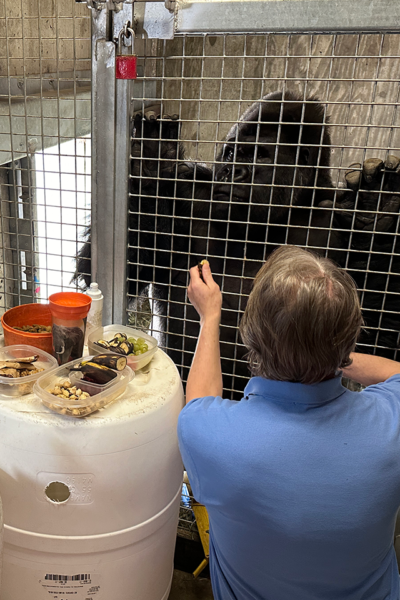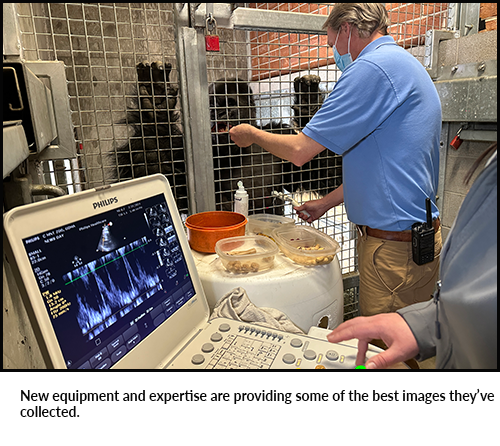
A charcuterie board fit for a king sits in the human side of a gorilla den. Peanuts, grapes, bananas, primate biscuits and handmade peanut butter-and-oatmeal roll-ups are lined up next to a souvenir CMZoo cup of juice, ready to reward an impressive set of skills. The goodies are for the king of Primate World – Cheyenne Mountain Zoo’s much-loved male Western lowland gorilla, Goma.
Just beyond the spread of sweet and savory snacks, on the gorilla side of the den, a blue plastic stool sits in a room covered in comfy hay with two open doors on either side. One brightly backlit door leads to the yard, where the sun is shining brightly on a warm February day. On the other side of the second door, CMZoo’s gorilla troop members, Asha, Kwisha, Roxie and Goma are lounging, foraging, building nests and interacting with guests through glass.
February is Heart Month and today is another heart health monitoring day, so a veterinary cardiologist is on site. Heart health is important regardless of age or species. CMZoo partner, Children’s Hospital Colorado, cares for some of the world’s smallest cardiac patients, while CMZoo cares for one of the biggest.
Goma will be 33 years old on March 31, and the median life expectancy for male Western lowland gorillas in human care, according to the Association of Zoos and Aquariums is 32.7 years. Unfortunately, heart disease is prevalent in older male great apes. Goma has heart disease and takes oral medication to prevent its progression. His disease is under control and his care team monitors his health with regular cardiac ultrasound readings provided by the local experts at North Springs Veterinary Referral Center.
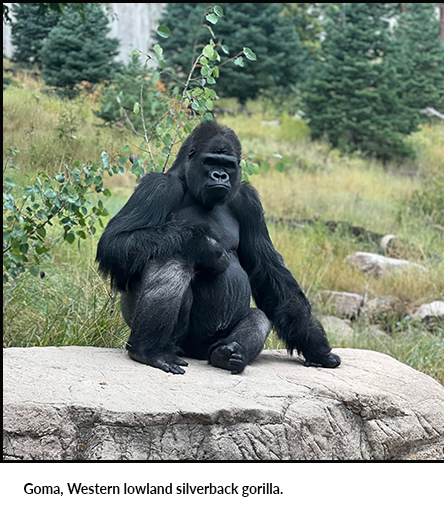
As the cardiologist follows Primate World Lead Keeper Jon Wild into the room, a commanding but tentative presence joins them from the other side of the mesh. It’s Goma, and he knows those tasty treats are for him.
“Hi there,” Wild says softly to the 435-pound silverback, who is taking his time scanning the room, his big brown eyes intently studying the faces beaming back at him. “We have some extra people in here today, don’t we? You’re okay. Do you want to come over here and do some ultrasound training with us? Just sit here on your stool, and we’ll get started.”
Goma isn’t hesitant about Wild, the cardiologist, the equipment or the observing keeper in the room. He’s familiar with this setup; he just did this a few days ago. It’s the two people here to learn about his training and take photos that he’s not so sure about. Wild reassures Goma, and Goma quickly settles onto his light blue spool seat, scooching up to the mesh for a refreshing gulp of juice.
Goma is comfortable, even with the new visitors, because his care team has earned his trust through years of relationship building. Goma established this ultrasound behavior previously, so once Goma got to know Wild, who has 22 years of experience working with great apes and has worked at CMZoo for over a year, they started building upon it. The most important part of Goma’s participation in the ultrasounds is sitting still – either on his stool or on the ground – with his chest close enough that Wild can slip the probe through the mesh onto Goma’s chest.
The sessions’ length is up to Goma. Sometimes they’re five minutes and sometimes they last over an hour. Wild communicates to Goma to reposition or to bring his chest closer to the mesh, and Goma sits still. Wild and the cardiologist communicate about the image on the ultrasound screen and where to move the probe to get the best views. All the while, Goma sits patiently and gets treats from Wild. But, there’s one element that sensitive Goma, who is a great student, isn’t shy about protesting.
“He doesn’t care for the ultrasound gel,” said Wild. “Some animals enjoy it and they rub it all over themselves, some don’t seem to notice, and Goma tolerates it, but not right away. We can’t figure out why. It doesn’t have a smell, and it isn’t menthol or textured. We warm up the gel so it isn’t cold. When he sees the gel bottle, he’ll lean slightly back and side-eye it until I present the best reward – his peanut-butter and oatmeal roll-ups or juice.”
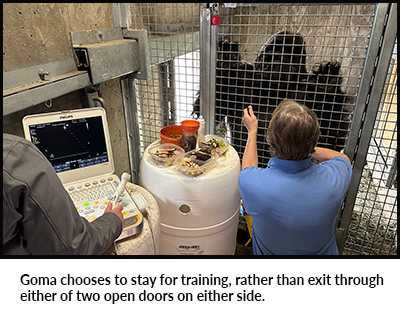
Once Goma agrees to let the gel touch his skin for the first time, he’s fine with it, but he is welcome to have a moment to communicate he’d rather not endure it at the beginning of each session. He’s a smart gorilla, and he negotiates throughout sessions. Sometimes he offers a more simple behavior compared to presenting his chest, like offering his shoulder or opening his mouth, to see if that will elicit a reward. If he wants to stop, he can always walk away, but that doesn’t happen often.
“We’re asking him to choose this over whatever he’s engaged in,” said Wild. “That’s why the high-value snacks are so important. The experience has to be his most rewarding option, which means having his favorite foods and knowing he’s in control. He also needs to be comfortable with the team. When we started working with this cardiologist, we introduced them while she gave him snacks and juice and talked to him so he could get used to her voice. We got lucky because Goma really likes her.”
His care team is excited about the images Goma has allowed them to collect on ultrasound. They say the equipment and expertise they have access to now is providing some of the best images they have been able to collect.
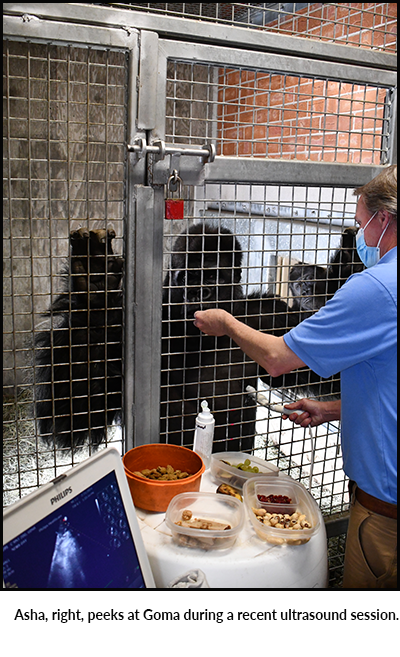
Making sure Goma’s medication is working is the top priority, but the images serve another purpose. CMZoo shares Goma’s heart health updates, images and medication regimen with the Great Ape Heart Project – a collection of great ape keepers and veterinarians who use this data to learn more about gorillas’ and orangutans’ hearts and share that with people who care for apes. That shared greater depth of knowledge can provide caregivers more treatment options and proven solutions for the great apes in their stewardship.
About 20 minutes into Goma’s session, another curious face appears in the room. This time, it’s not a person, it’s 31-year-old Asha, who is Goma’s number-one in the troop.
“She wants a turn,” said Wild, gesturing toward Asha. “Most of our great apes participate in some kind of heart monitoring, whether that’s EKG readings or blood pressure monitoring through their fingertips, or ultrasounds. Asha is also working on an ultrasound behavior on her belly.”
Asha, who has a breeding recommendation with Goma, is eager to train with Wild. But, Goma is the dominant animal in the group, so Asha doesn’t interfere beyond glancing toward Wild and Goma to make sure they have noticed her playing with a few little pieces of hay in the doorway to the den. Once Goma is finished training, Asha comes into the den and Wild places the probe on her abdomen, but doesn’t see anything exciting. Asha and Goma have been seen breeding, but there’s no evidence it has been successful.
CMZoo will continue to share updates as the group continues to train, bond and grow as a cohesive group.
